Smudging, Sacred Bowl Blessings
- Details
- Written by CrystalWind.ca
- Views: 11073
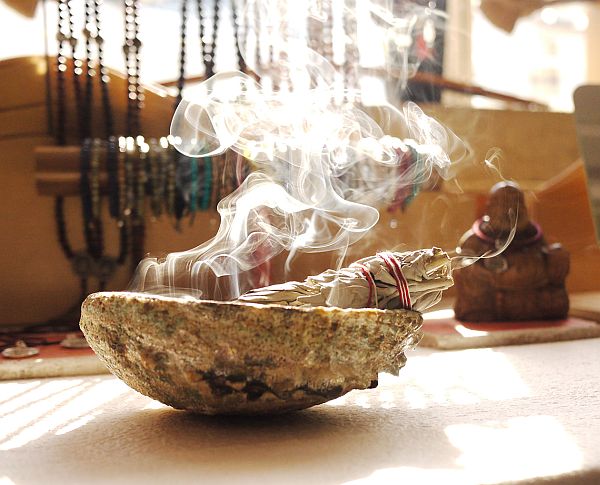
The practice of burning herbs, resin, or incense has been used by many cultures around the world since ancestral times as part of spiritual and healing traditions to purify mind, body, and spirit.
The smoke from burning sacred plants binds with the stagnant or negative energy of people, places, and objects and carries that energy to a place where it can be regenerated and returned to the cycle as a beneficial force.
Smudging has become an important part of moving into sacred space, the familiar smell of burning sage or copal wakes up deep cellular memory, helping the drop into ritual space, bringing the spirit back into the body, into the moment, stilling the mind as you shed the concerns of the day to focus on the work to come.
Whether you’re on your own, preparing for a healing session, or gathering as a circle, smudging can help create sacred space, clearing the energy of previous occupants from the place where you will be working and opening the way for what is to come. It can also be helpful to dispel the residual energy left after an argument or disagreement with another person or within the circle. The smoke of sacred plants is very healing to body and spirit, and can be a wonderful support for yourself or loved ones when you’re experiencing or have been exposed to sickness, unsettled emotions (fear, depression, anxiety, anger…), stressful situations, or when you feel like you’re taking on negative energy from the place you’re in or the people around you.
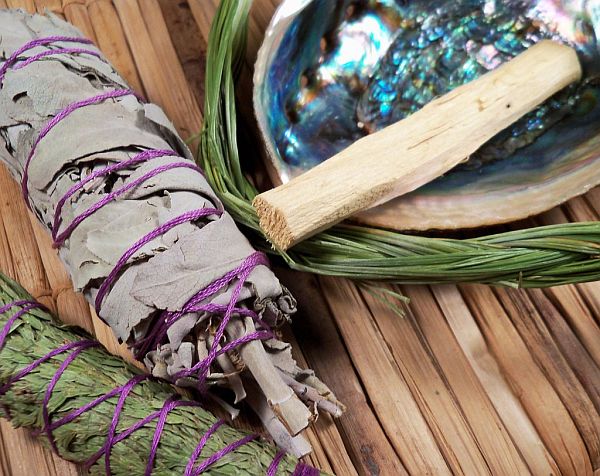
Herbs to Use
All plants are sacred, so treating our smudging material with respect is very important. We’re asking their beautiful spirits to come in and help us, so helping them feel welcome and comfortable is part of our honouring our agreement with the plant people.
Various traditions have strong affiliations with certain plants. When deciding what plants to use for smudging consider which ones resonate with you, try to collect them yourself when possible, or become familiar with what they look like when they’re growing, where they grow and under what conditions they thrive. Whether you harvest them yourself or purchase them from someone who did, make sure to give thanks to the plants, telling them how you hope to use them, and try to avoid using ones that are threatened in the wild or were harvested in an unethical manner. As always, only take what you need and make sure to ask the plants first. You may want to journey to the spirit of the plant and ask what wisdom the plant has for you, or if she or he is the one you should smudge with. Consider using plants that support your energetic intention: clearing and releasing, healing, protecting, opening to your intuition, and so on. Many of the plants that have been used to smudge with since ancient times have a natural affinity for the threshold, for transition, and can be a great support as you create ritual space and prepare to move between the worlds. In addition to your own feelings and wisdom about the plants, there are many books on their energetic properties that you could consult to learn more. Asking the plants to bring these gifts while you burn them can help you strengthen your intention and their willingness to participate with you. Below are some examples of plants and resins often used for smudging, most of them have strong, aromatic volatile oils that are released when the plant is burnt. Feel free to use others though, if you feel a strong connection or if a certain plant is significant to your tradition. Always check that the plant you hope to use is not toxic or harmful when burnt, before you smudge with it.
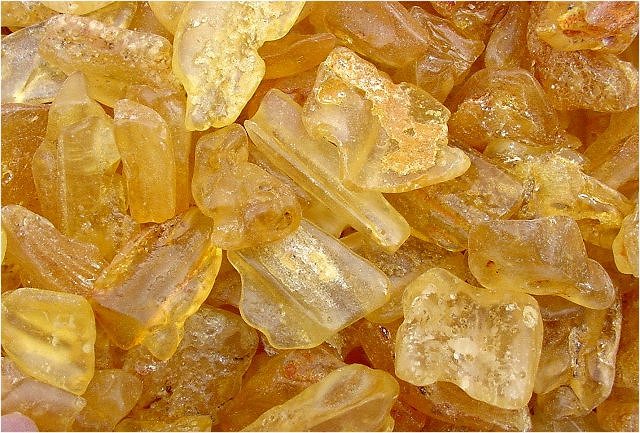
Copal: Copal is a tree resin that has started to mature through exposure to heat and pressure, though not yet enough to have turned into amber. Copal can be found around the world, even within Mesoamerica, the home of the copal we use, there are several trees whose resin is called copal, or “pom.” Bursera bipinnata, B. ordorata, B. excelsa, B. tomentosa, B. jorullensis, Pinus pseudostrobus, Hymenaea verrucosa, H. courbaril (the palojiote tree) from southern Mexico, all produce the resin that will become copal. Sweet, spicy, earthy, and woody, its name comes from the Nahuatl word copalli, and means incense, a holy substance for the people of early Mesoamerica who still use incense as part of almost all rituals. Copal was burnt in their temples during ceremony and temazcal sweat rituals. Copal smoke can be used for protection, to cleanse the body, and divination. To divine with copal a shaman will interpret the patterns that appear in the smoke, or will hold 14 grains of corn in the smoke, chant and cast the grains then read how they fall. Shamen may have also used copal smoke to help them enter a trance state. There is a strong link between copal resin, “the blood of the trees” and corn. For native peoples copal is known as food of the gods, just as corn is food of the people. Copal was often shaped into ears of corn or tortilla and used as offerings. The Lacandón Maya believed the smoke of copal turned into tortilla for the gods, so copal was offered during many ceremonies and was an absolutely necessary part of the deer hunt ritual of the Chorti, where a hunter would wait for a dream of how many copal tortilla to offer the deer spirit before the hunt could be initiated.
Sage: Sage is the flower of immortality and protector of life, her Latin rootsalvia, means salvare, to heal, and we still call someone who is wise and experienced a “sage.” Known as sukodawabuk by the Ojibwe people, sage represents the west and is used to make prayers and to tell the Creator when you need help. Sage helps us harvest wisdom from our experiences so we are able to share that wisdom with others, finding our timeless center, especially during times of transition, so we can come into alignment with our life’s purpose.
Garden Sage: Salvia officinalis, aromatic, thick-stemmed and sturdy, her beautiful, purple flowers rise tier upon tier above furry, smoke-green leaves.
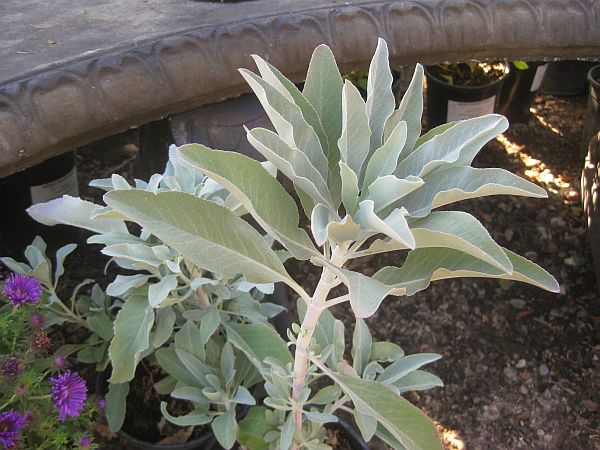
White Sage: Salvia apiana, also known as bee sage, California white sage, and salvarial, happily grows on rocky, hot, dry slopes of the American southwest. This airy, richly aromatic plant is calming and cleansing, an excellent smudge for meditation, divination, and purification. The smoke of the burning leaves can be used to release negative energy and welcome the new on a physical as well as energetic level. White sage can help our body rid itself of illness whether brewed into a tea for cough and colds, or added to a sweat bath for fever. White sage’s purifying nature helps move toxins out of our physical bodies and can be burnt to purify the air after exposure to illness. If you enjoy gardening, consider growing your own white sage to ease the pressure on wild populations. As a side note, new research is showing that the estrogen like constituents in white sage may be beneficial for menopausal and post-menopausal women, another blessing of woman medicine that sage gives our circles.
Sagebrush: Artemisia californica, grows in the southwest of North America, a thick and shrubby plant with small leaves full of refreshing, sharply sweet volatile oils. Sagebrush always makes me want to breathe as deeply as I can, taking the sweet, clean smell into every corner of my lungs. Sagebrush is very sacred to native peoples and is used to purify people, objects, and places by helping us release negative energy. A sprig can be packed with sacred items to keep them clear of energies that they may otherwise pickup as you carry them around, or tucked into a medicine pouch that you wear.
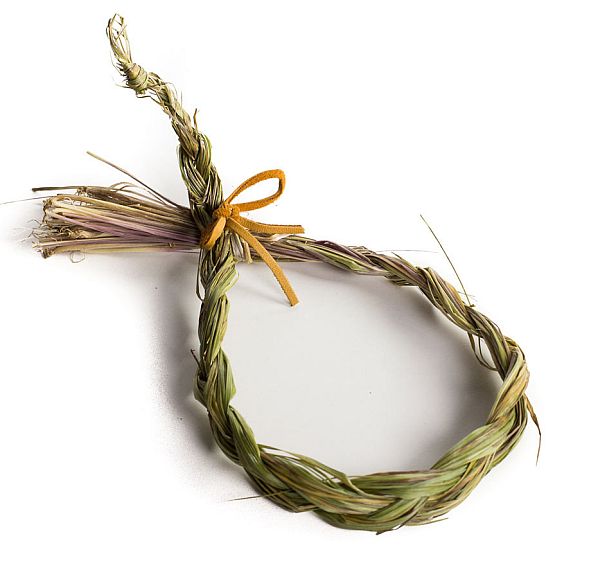
Sweetgrass: Hierochloë odorata, also known as Seneca grass, holy grass, and vanilla grass, sweetgrass is circumpolar and can be found in the northern parts of North America and Europe. A very sacred plant, the hair of Mother Earth, sweetgrass is often braided before she is clipped from the Earth. The three strands of the braid represent mind, body, and spirit, and the strength that comes from weaving those parts of ourselves together, as well as the unity that comes from weaving strong communities. Sweetgrass is the airy, sweet, light smell Mother Earth’s breath, a reminder of the love and nurturing she provides us. It is thought by some that ancient people may have carried sweetgrass plants to North America when they migrated across the Bering Strait, nurturing this beautiful, sweet plant as the Earth nurtures us. When burnt, sweetgrass is cleansing and inviting to helpful spirits and positive energy. Sweetgrass is know as weengush and represents north and the body to the Ojibwe, who fan the smoke to their heart, then to their head, then around their body, and back into the heart while praying "Great Mystery, please cleanse me of my negativity and fill me with the positive energies of love, so that, as I am healed so may I work for the healing of our Earth Mother.” Consider cultivating your own sweetgrass as the ancients did, or seek out braids that have been carefully harvested to reduce strain on the wild (or feral as the case may be) population.

Tobacco: Nicotiana spp. is a very sacred herb that is given in thanks by the native peoples of North America to the Creator, Mother Earth, and our ancestors for the many gifts we have been given. When you take something from the earth, explain to the plant why and offer some tobacco in thanks. Tobacco is a friendly spirit who acts as a medium between us and spirit, and is an important part of purification ceremonies so one can be clear of heart and mind when approaching Mother Earth and asking her to provide for us. Offer tobacco at the beginning of storms, when you begin a journey, when you find a feather, or harvest food. Tobacco with its roots deep in the earth and smoke rising high to the sky connects the worlds, holding our prayers and carrying them to spirit, opening us to spiritual guidance and growth when used in a sacred way. Some prefer to reserve the use of tobacco for prayers in sacred pipes or for offerings. For the Ojibwe, tobacco, or semah, is the sacred plant of the east and the mind, opening the door to the Creator. Tradition would have you hold tobacco in you left hand, the hand that is close to your heart, as you say your prayers of thankfulness in your native language. Tobacco assists when you want to make amends with someone (or something), or offer in thanks to the elders when seeking advice or a ceremony. Though Nicotiana tabacum was preferred by early Europeans and has been more common since colonial times, Nicotiana rustica was the variety grown by native people in North and South America.
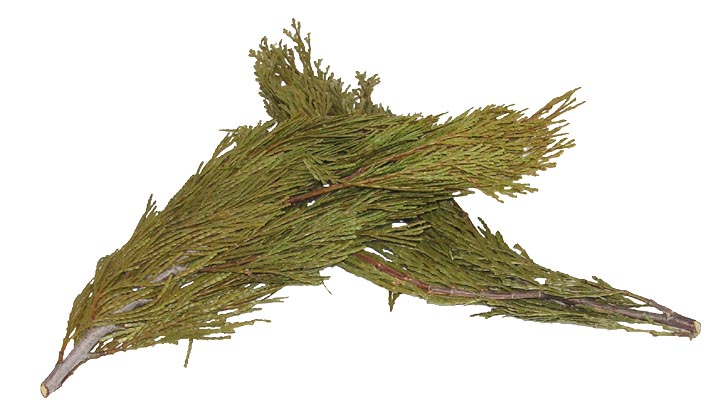
Cedar: The name “cedar” has come to be associated with many different tree genera including: northern white cedar or arbor vitae (Thuja occidentalis) which grows in wet forests and swamps, atlas cedar of the Atlas Mountains of Algeria and Morocco (Cedrus atlantica), eastern red cedar (Juniperus virginiana), and California incense cedar (Libocedrus descurrens) to name a few. Like all evergreen trees and shrubs, cedar embodies a spirit that lives on through the cycle of life, death, and rebirth. In the Cherokee tradition, the Creator made the cedar tree, known as a-tsi-na tlu-gv (ah-see-na loo-guh), to have a place to set the spirits of those who died during the long winter. For the Ojibwe, cedar is known as keezhik, and represents the south and the soul, and is burnt while meditating and praying to the Great Mystery. Cedar trees hold powerful protective spirits, so pieces are often carried in medicine pouches or made into drum frames. The spirit of cedar is very old and wise and can be asked to carry prayers to Spirit like tobacco. Cedar is earthy, grounding, balancing, and harmonizing. In the same way its wood resists decay and repels insects and fungus, cedar incense can be used to ward away sickness, clear negative energy and welcome in positive energy. As it can thrive in swampy wet places, cedar helps us resolve cold, damp conditions, supporting decongestion of the lymphatic system, fluid retention, and breaking down fat that has accumulated in our bodies, helping us put down strong roots during times of external change or when we find ourselves in unfamiliar places, allowing us to take in these new situations that may feel threatening help us to draw strength and wisdom from them. Cedar encourages us to tap into our abundant, spiritual power and will, and as such is excellent to burn when consecrating magic wands, a tool used to focus and channel our will.
Pine: Pinus spp. is most often used in its resin form, though the dry needles can also be added to a smudge mixture. Pine is a tree of protection, cleansing, strengthening, and soothing to the soul, bringing balance and harmony. As the turpentine oil that is distilled from pine (Pinus sylvestris) can be used to make solvents for paint, medicinally pine helps dissolve cold, phlegmy conditions, and is warming and drying, increasing circulation and helping the body eliminate toxins, supporting the lungs, kidneys, and joints. Pine is burnt with cedar and juniper by native peoples of North America during sweat lodge purification ceremonies, and can be asked to help dissolve melancholy, undue guilt, and restore our energetic boundaries. Feel out the nature of the different species if you decide to use them in incense, to me white pines feel cool, cleansing, graceful, and soft, while pitch pines feel sturdy, hot, dry, and thick with sticky resin.
Juniper: Juniperus spp. is a low, prickly, evergreen shrub or small tree that grows in well drained, poor soil in rocky mountainous areas or on heaths and lowlands. Juniper is ruled by Mars, fiery, sharp, piney, warming and stimulating to the kidney and lymph systems. Cutting through cold and damp physical, psychic, and energetic stagnation, juniper’s warm, sweet openness stimulates and revives the weary soul. Since ancient times, juniper has been used as an antiseptic fumigant and for spiritual purification, burnt in temples to aid clairvoyance and connection with other worlds.
Mugwort: Artemisia vulgaris is a guardian of the threshold, happily growing in sunny meadows and hedgerows, her flowers pollinated by the wind, she protects travelers from malevolent spirits and fatigue. Mugwort is a magical plant, ruled by the Moon and Venus, helps wake up our psychic senses and intuition, inducing lucid dreaming, making dreams more vivid and easier to remember upon waking. Mugwort is an ally for women during their moon time, bringing warmth to the womb, just as moxa, made from another type of mugwort, is placed on specific points on the body and burnt during acupuncture treatment to bring warmth to those points on the body. Mexican mugwort incense was used by the ancient Aztecs to activate their magic mirrors and mugwort is known by native peoples in North and South America as a plant of divination and spiritual healing.

Lavender: Lavandula angustifolia, is also known as English lavender, true lavender, and elf leaf. Low and shrubby with a cloud of pale purple flower spikes and downy, green, lanceolate leaves, lavender loves dry, sloped, sunny places, where sun and air help concentrate her rich, aromatic, volatile oils. Her name derived from the Latin lavare, “to wash,” reminds us of her long use as a purifying and cleansing herb, as well as her ability to repel insects and pests. Lavender’s airy and refreshing oils are soothing, balancing, and harmonizing. She creates an atmosphere of peace and love, easing grief, depression, and dispelling excess heat so we can break old patterns and open to our full expression of self. In the same way lavendar’s flowers produce abundant nectar for bees to turn into beautiful honey, she supports us as we work to manifest our own honey from the richness of our essential selves. Lavendar is often associated with elves and fairies and is dedicated to Hecate and the Virgin Mary, a breath of the spirit world that helps open our crown chakra, connecting us with our higher selves and aiding us during meditation and divination.
Yerba Santa: Warm, pungent, astringent, and sticky, yerba santa (Eriodyction glutinosum, E. californicum) is also known as bearsweed, consumptive's weed, mountain balm, tarweed, and holy herb by the native peoples of western North America where this low, shrubby, evergreen grows in the dry, rocky hills. Bees love her flowers and make spicy honey from this aromatic plant’s nectar. Yerba santa helps the body eliminate toxins via the urinary system, aids cough by relaxing bronchial spasm, and helps the heart release grief and sadness that have settled in the lungs, restoring joy and easy breathing. Ruled by the moon, yerba santa’s aromatic oils can be asked to support meditation and divination, enhancing psychic abilities, and magical protection.
Hibiscus: Hibiscus rosa-sinensis has a beautiful five petaled flower and is ruled by Venus, embodying the dance between fire and water. Hibiscus has a long lasting sharp, invigorating scent that awakens our senses and supports our life force, helping us reunite our sexuality with deep feelings of love and affection. Hibiscus can be used during divination, opening our psychic abilities.
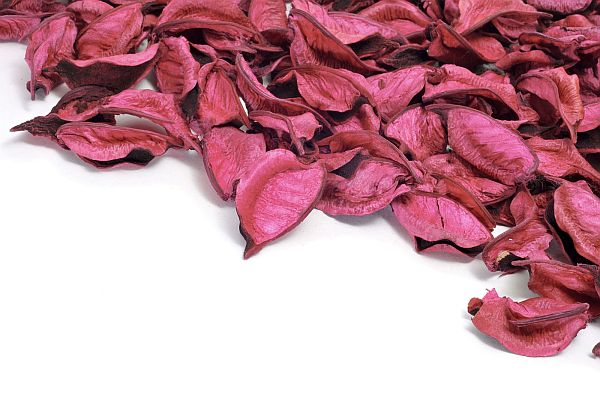
Rose petals: This flower of love and compassion is also sacred to Venus. Beautiful and sensual, heavy, warm, aromatic rose (Rosa spp.) embodies water, cool and moist, she helps clear hot inflamed or tense, stagnant conditions. Rose is soothing to the nerves and skin, and decongesting for our wombs, restoring and supporting the heart, uplifting the spirit, healing emotional wounds, and helping us find and celebrate the natural beauty of our bodies and sexuality while we open to love, and act on our desires. Rose can aid us in meditation and divination, opening our psychic abilities and our connections to beings from other dimensions. When using rose, pick the color that feels like it supports your intention, or simply feels irresistible.
Osha: Ligusticum porteri, also known as chuchupate, empress of the dark forest, bear medicine, Colorado cough root, and porter's wild lovage, osha is a powerful root that grows in the high meadows of Rocky Mountains in western North America. Bears have long been teachers for us about herbal wisdom and osha is like catnip for them, they happily roll in it and wash themselves with chewed up roots. They also eat osha root to cleanse their digestive systems when they first come out of their dens in the spring. Humans have long used osha to support the lungs, to bring warmth and strength to the respritory system, especially at high altitudes, and to sweat a flu. Osha can be burned for protection, and was smoked by Jicarilla Apache (who call osha ha’ich’idéé) and other native shamen as a part of ceremonies. Osha has resisted domestication, and its stuborn and strong roots often grow amongst tree roots, making them dificult to harvest.
Myrrh: Commiphora molmol is earthy, smoky, piney resin is gathered from a sturdy, almost leafless shrub that lives in the hot, dry regions around the Red Sea. Myrrh can teach us about release and transformation, and was used by ancient Egyptians for healing (the resin is rejuvenating, antiseptic, and helps prevent disease) and when people were dying. Myrrh can be asked to help connect with the spirit of youth, and remove obstacles to your truth, instilling a sense of confidence, stability, and enlightenment.
Frankincense: Boswellia carteri, also known as olibanum or salai guggal resin is fiery and very smoky. Harvested from an African tree, frankincense has been used by many spiritual traditions through time. Inhaling the smoke slows the pulse and deepens one’s breathing, aiding focus on meditation and prayer, and open to blessings from the divine. Medicinally frankincense can be stimulating to the airways, helping relieve asthma, bronchitis, cold and flu, and has been used during labor to help focus breathing.
Other important herbs that are often part of pipe smoking rituals for the native peoples of North America include: mullein (yerba del lobo, strong lung medicine), red willow bark (chanshasha, a type of dogwood, some call the mix including red willow bark “kinikinik” the Algonquin word for “mixture”), and uva ursi (Arctostaphylos uva-ursi, bearberry, kinni kinnick).
How to Smudge
The tools you use to smudge with are sacred. Since smudging calls us to the center of ourselves, and the center of the four directions, some traditions use plants that hold the essence of the elements of earth, air, water, and fire, or use tools that represent those four elements when they smudge. A bowl is often used to hold the plant material. Bowls often represent the feminine, water, emotion, the womb rich with potential, the beautiful container that holds the food that nourishes us. Some use a large shell since shells are formed by creatures that once lived in the ocean, and hold the energy of water and the sea, mother of us all. The luminous abalone shell in particular, grows in a spiral, the pattern of life. It’s important to note that some traditions in the Pacific Northwest feel that abalone shells are very sacred to Grandmother Ocean and should be used for water ceremonies, not fire ones, and that smudge should be held in bowls of stone or clay. As with everything, feeling your way and asking permission first is always a good idea, and a necessary part of staying in good relationship with the seen and unseen powers that surround us. It never hurts to dowse with a pendulum or embark on a shamanic journey to check it out with the spirit of the shell or your guides and teachers. The smoke itself represents air and can be fanned over your body with your hands or a feather. A bird used the feather to fly through the air, and can help carry our prayers to the sky people. The herbs themselves bring the energy of the earth where they grew, and the flame that lights the dry herbs brings the bright fire, an intimate version of our beautiful sun. It’s important to express our gratitude, thanking the shell, the plant people, the bird, and the flame for the gift they have given us each time we use parts of them to smudge.
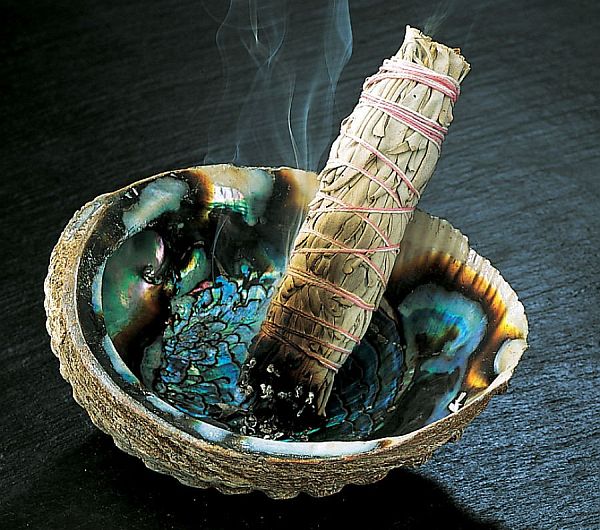
As you begin to smudge, hold the intention that the smoke and the spirits of the plants help cleanse the energy of your body, mind, and spirit, the place, or the objects your working with. Dry plant material can be bundled, or placed loose in a clay or stone smudge pot or shell. Metal smudge pots can also be used but take care because they may become quite hot as the plant material burns. Resins and some plant materials burn best on a hot charcoal tablet or charcoaled mesquite. If you are using a charcoal tablet make sure you burn it on a thick layer of sand in a ceramic bowl, as shell may crack from the intense heat. Loose or bundled leaves can be lit with a match or candle and allowed to smolder in your smudge pot or shell. If using a mix of plant material, make sure some of each type of plant is lit in the smudge pot. Once lit allow the flame to die back so the plants are smoldering, offer smoke to the four directions (if smudging in circle this only needs to be done by one person) then use your hands or a feather to fan the smoke over your aura and body, taking care to smudge your back as well. As you smell the smoke you are also drawing the cleansing energy of the plants to the inside of your body. It may help to fan smoke into places where you feel energetic blocks or would like to direct healing, the smoke can also help mend gaps in our etheric bodies. Use your feather to fan the smudge if it begins to go out, relighting the plant material if it goes out.
Smudging another person can be part of welcoming them to a ceremony or as part of a healing treatment. When smudging another person, hold a cleansing, clearing intention for them as you fan smoke over their body, or if you are being smudged by another, open to receive this clearing. Some like to offer words expressing their intention when they smudge another person. When used as part of a healing session the smoke can help clear your client, opening them to the gift of the healing.
Smudging sacred tools, clothing, and other items before using them in ceremony or ritual helps clear them of energy they may have accumulated during prior use.
To clear the energy of a room, walk the perimeter of the space with the burning plants, fanning extra smoke into the corners, behind doors, and places that feel uncomfortable. Some recommend moving clockwise around the room as that’s the way the sun moves in the sky. Others recommend moving counter-clockwise as that’s the direction you move when you wish to release or dispel energy. Some traditions recommend using plants to clear and purify the area, then ones that welcome in positive energy, followed by a lit white candle to bring light throughout. When clearing a house or dwelling, some recommend smudging around the outside after you do the inside.
No matter what you’re smudging take care to leave a window open so the smoke can escape and carry the energy to where it can be regenerated into useful energy for others. This also helps prevent setting off smoke alarms, which clears energy in another way, but may not be conducive to the mood you’re building.
It may be helpful to place some sand or earth in the bottom of your smudge pot or shell so when you’re done smudging you can damp the smoldering herbs out against the sand. Some people use their fingers to do this, or another piece of plant material. Return any matches and ashes that accumulate carefully back to the earth once they are cool, thanking the plants and the fire, allowing them to nourish the soil.
Smudging is a wonderful practice to use regularly, connecting you with source, with your center, with those around you, clearing stagnant or negative energy that may block us from the wisdom or healing that is trying to come through to us. Smudging creates a place where we are able to receive new awareness and understanding, an opening so we can move into sacred space with a good heart.
© 2009-2024 crystalwind.ca. All rights reserved.
Liked this article? Dive deeper into personal growth and wellness! Check out CrystalWind.ca for spiritual wisdom or explore AromaWorx.ca for natural well-being tips. Spread the positivity—share this with friends on their happiness journey!
Let’s Chat! Drop Your Thoughts Below! ![]()
Latest Articles

Imagine a world of inspiration and healing, free for all—made possible by YOU!
Donate Now—Ignite the Magic at CrystalWind.ca!

Epilepsy - Finding A Cure
Your donation can make a difference!
Help us find a cure – donate now!
Unlock Your Light: Join Lightworkers Worldwide on CrystalWind.ca!
Articles: Tarot
Follow Us!
Featured This Month
Virgo Mythology
The Virgo Myth In all of constellation mythology, few legends are as misund... Read more
Peridot: The Healer's Stone
Peridot has been used as a Power Stone for centuries. Peridot fosters emotio... Read more
Crystals for Virgo
As the warmth of summer begins to soften into the crispness of autumn, the Sun... Read more
Watermelon Tourmaline
Synonym: Rainbow Tourmaline The watermelon tourmaline is a rare variety t... Read more
Sweet Violet
Sweet Violet Faithfulness and modesty. “I will always be true to you.” Helps... Read more
Mabon Magic: Ideas For Fall Decoration And R…
Welcome (almost!) to Fall! We’re turning the Great Wheel once again, toward ... Read more
Sun in Virgo
An Overview of Sun Sign Characteristics for Virgo Virgo is guided by Mercur... Read more
Mabon in Modern Times: Fresh Takes on the Au…
The Mabon season begins somewhere around the 21st-22nd of September and cont... Read more
The Vine: September 2nd - September 29th
The Autumnal Equinox ( Alban Elfed ) Celtic Symbol : The White Swan Read more












































